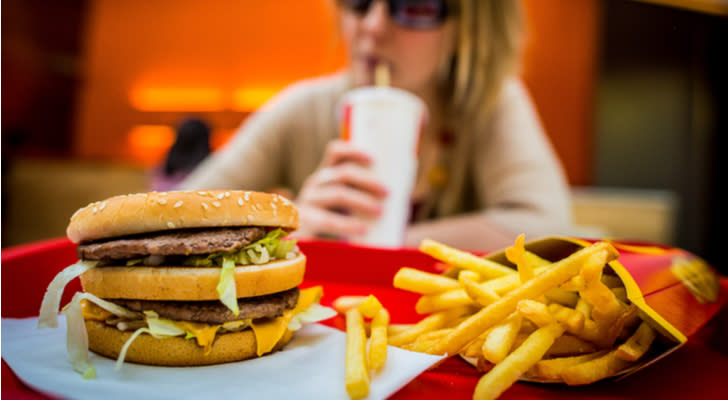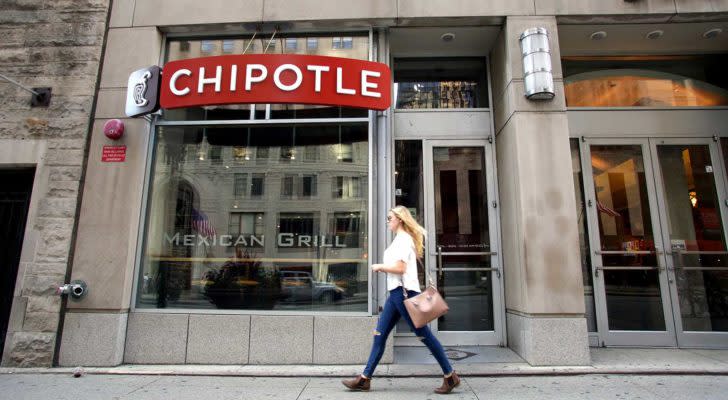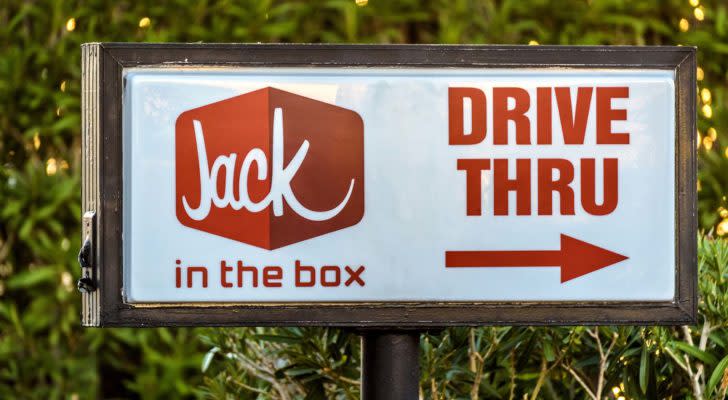3 Fast Food Restaurants Planning to Hike Prices to Offset New $20 Minimum Wage
California increased the minimum wage for fast-food workers to $20 per hour on April 1, potentially prompting higher restaurant prices. The new law also establishes a fast-food council authorized to annually adjust wages by up to 3.5% based on inflation. California’s minimum wage is $16 hourly, surpassing the federal rate of $7.25.
Fast-food restaurants intend to raise menu prices to counterbalance the increased wages. According to Jon Tower, a Citi analyst specializing in restaurants, these higher prices, ranging from 5% to low-double-digits, may deter some customers, potentially resulting in reduced foot traffic.
That said, three fast-food chain restaurants came forward with the idea that price hikes might soon be happening to their menus to cope with the $20 minimum wage increase.
InvestorPlace - Stock Market News, Stock Advice & Trading Tips
McDonald’s (MCD)

Source: Shutterstock
McDonald’s (NYSE:MCD) has continued to raise menu prices, which deterred some customers. CFO Ian Borden acknowledged consumer concerns about pricing during an earnings call, and CEO Chris Kempczinski noted declining order sizes, particularly among low-income patrons. Despite previous claims, recent price hikes affect consumer sentiment negatively.
After the news came out, it garnered a lot of sentiments and comments on social media from the public. Consumers were disappointed with the increased fast-food prices, which also showed decreasing value. So far, McDonald’s has raised menu prices by 10% in the past year. The company also made increases in 2022.
With inflation easing, customers anticipated milder price increases this year, noted Borden, mentioning that franchisees determine their pricing. Kempczinski highlighted the pressure on low-income consumers, particularly those earning $45,000 or less, with this demographic shrinking due to more affordable home-cooked meals.
While the cost of home-cooked food increased by approximately 1.3% in 2023, dining out at limited-service restaurants, such as fast-food establishments, saw a steeper rise of 5.9%.
Kempczinski anticipated low-income customers favoring lower-priced menu items over promotions. He emphasized the importance of affordability for this demographic, noting that temporary deals might have less impact in 2024.
McDonald’s aims to emphasize its D123 platform, offering items priced at $1, $2 and $3. Kempczinski also added that most of the chain’s market behavior was driven by middle to high-income consumers. That has either maintained or increased McDonald’s market share.
Chipotle (CMG)

Source: Northfoto / Shutterstock.com
Another popular fast food chain that has expressed its price hikes is Chipotle (NYSE:CMG). The company released a statement saying it will implement some necessary prices for California customers following the increased minimum wage in the state. Chipotle CFO Jack Hartung also explained the need for the company to do these as they need to offset labor costs — which were significant for Chipotle.
Before the enactment of AB 1228, California’s fast food workers were earning an average of $16.21 per hour. The law allows annual minimum wage increases of up to 3.5% based on inflation. Chipotle, with 475 locations in California, pays its workers an average of $17 hourly. Hartung refrained from specifying the extent of the impending price hikes but noted a steak burrito currently costs around $11 in the state.
Chipotle initiated automation technology trials in the past year to reduce labor expenses. That included testing robots for avocado preparation and developing a burrito bowl-making robot. Labor costs rose by 11% to $2.44 billion, compared to $2.91 billion spent on food, beverages and packaging. The New York Post reached out to Chipotle and Governor Gavin Newsom for comments.
On February 6, during an earnings call, Hartung also highlighted some points on the company’s financial standing. He confirmed some plans for 2024, including price hikes in Q1. The price increase is said to be between 2.5 to 3%. However, the exact adjustment remains undecided. The company is considering raising prices enough to break even or slightly more to maintain profits.
That decision depends on factors such as consumer sentiment and actions taken by competitors. This upcoming increase follows previous adjustments in response to rising operating costs and inflation, including a nearly 4% increase in June 2021 and a roughly 13% increase in October 2022 compared to the previous year.
Jack in the Box (JACK)

Source: LifetimeStock / Shutterstock.com
During recent earnings calls, Jack in the Box (NASDAQ:JACK) CEO Darin Harris stated the company would depend on price adjustments, expecting menu prices to increase by 6% to 8%. The uncertainty lies in how customers respond to these hikes and their impact on sales projections. Other businesses in California are expected to follow suit, with anticipated price increases around 10%. The challenge lies in balancing raising prices and maintaining customer value.
It wasn’t very long ago that this famous fast food company faced challenges, leading it to lower its inflationary pressures. According to Harris, most of Jack in the Box’s sales decline was from operational challenges, which they need to offset.
Despite these challenges, increased pricing and operational improvements helped franchisees enhance the guest experience. To counter traffic declines and inflation, the company implemented a nearly 10% price increase during the quarter, strengthening the average check and prioritizing value moving forward.
During the same time, CFO Timothy Mullany mentioned that a 9.7% price adjustment helped the company navigate the cost environment. Jack in the Box emphasized menu innovation as a key strategy for value creation, contributing to its quarter performance. New offerings like the grilled chicken sandwich, Girl Scout cookies shake and the return of popular items such as popcorn chicken were introduced during this period.
Bottom Line
While some may think the fast food industry is inflation-proof, there is evidence that fast-food businesses can struggle during economic uncertainties like this. Food companies still pay for human labor, types of machinery and other operational costs. Although the increased minimum wage is good for individuals, it is a fact that it’s a business problem.
While most of America may see some relief in fast-food prices, Californians should brace for larger increases in 2024 due to the state’s minimum wage hike to $20 an hour in April. In response, several fast-food chains are considering mid-single-digit price hikes, contingent on consumer sentiment and competitor actions.
Additionally, delivery orders generally come with higher menu prices. Shake Shack (NYSE:SHAK), for example, recently raised premiums for digital orders.
To increase revenue, fast-food chains also expand digital order kiosks, encouraging larger orders and customization spending.
On the date of publication, Chris MacDonald did not hold (either directly or indirectly) any positions in the securities mentioned in this article. The opinions expressed in this article are those of the writer, subject to the InvestorPlace.com Publishing Guidelines.
Chris MacDonald’s love for investing led him to pursue an MBA in Finance and take on a number of management roles in corporate finance and venture capital over the past 15 years. His experience as a financial analyst in the past, coupled with his fervor for finding undervalued growth opportunities, contribute to his conservative, long-term investing perspective.
More From InvestorPlace
The #1 AI Investment Might Be This Company You’ve Never Heard Of
Musk’s “Project Omega” May Be Set to Mint New Millionaires. Here’s How to Get In.
It doesn’t matter if you have $500 or $5 million. Do this now.
The post 3 Fast Food Restaurants Planning to Hike Prices to Offset New $20 Minimum Wage appeared first on InvestorPlace.
